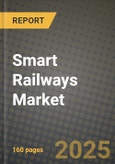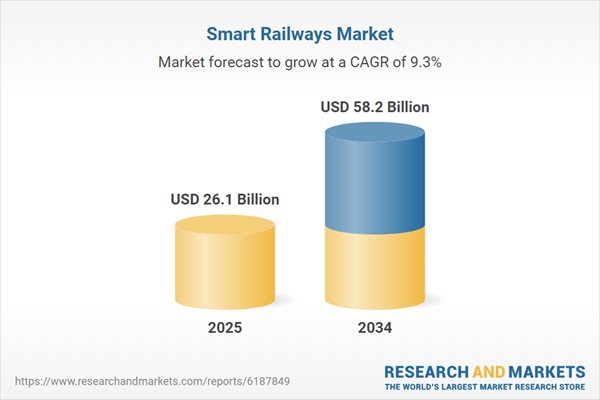The smart railways market represents a transformative shift in global rail infrastructure, where traditional systems are enhanced by advanced technologies to improve operational efficiency, safety, passenger experience, and environmental sustainability. Smart railway systems incorporate elements such as predictive maintenance, real-time monitoring, data analytics, automated ticketing, and communication-based train control (CBTC). These innovations aim to optimize traffic management, reduce downtime, and support high-capacity, high-frequency rail services. Governments and transportation authorities worldwide are investing heavily in digitizing railway infrastructure to meet growing urbanization, reduce road congestion, and support decarbonization targets. Public-private partnerships are increasingly common, especially in emerging markets, to fund these large-scale upgrades. With global momentum toward sustainable mobility and smart city development, railways are viewed as critical arteries that can efficiently connect people and goods across urban and intercity corridors using intelligent, data-driven platforms.
The smart railways market saw strong advancement across multiple regions, propelled by green infrastructure funding and technology integration. European rail operators expanded deployment of Internet of Things (IoT) sensors across train fleets and rail infrastructure to collect and analyze performance data in real-time. CBTC systems were further integrated into urban metro networks in Asia, enabling greater train frequency and safety. Artificial intelligence and machine learning were increasingly used in predictive maintenance applications, enabling earlier detection of track defects and component wear, thereby reducing disruptions. Digital ticketing and facial recognition-based boarding gained traction, especially in China and select European cities, offering contactless and efficient passenger movement. Meanwhile, trials of autonomous rail vehicles and platooning of freight trains began in regions like North America, signaling the next phase of automation. 5G pilot programs were also launched to test high-bandwidth connectivity across train systems and stations, aiming to support enhanced passenger services and real-time operational control.
The smart railways market is expected to evolve into a fully connected and automated transport ecosystem. There will be wider adoption of digital twins for rail networks, allowing operators to simulate and optimize operations, manage energy consumption, and reduce delays through predictive analytics. Integration with Mobility-as-a-Service (MaaS) platforms will enable passengers to plan, book, and pay for multimodal journeys through a single interface, improving convenience and network efficiency. Governments are expected to mandate greener, smarter rail systems as part of their climate action plans, driving adoption of electrified and hydrogen-powered trains paired with smart energy grids. AI-based video surveillance and biometric systems will enhance station security and streamline passenger flows. However, the success of smart railway expansion will rely on robust cybersecurity frameworks, standardization across rail systems, and training programs to upskill railway personnel. These efforts will determine how efficiently and safely smart railways can scale globally while addressing public expectations and regulatory scrutiny.
Key Insights: Smart Railways Market
- Expansion of Communication-Based Train Control (CBTC): CBTC systems are becoming standard in metro and suburban lines, enabling more trains to operate on the same track safely, increasing capacity and reducing congestion in dense urban centers.
- Integration of AI for Predictive Maintenance: Rail operators are using AI-driven analytics to monitor infrastructure and rolling stock conditions in real time, minimizing unplanned service disruptions and lowering long-term maintenance costs.
- Adoption of Digital Ticketing and Contactless Boarding: Contactless fare systems, including mobile ticketing and biometric validation, are improving passenger convenience and reducing queues at stations, especially in high-traffic metropolitan areas.
- Emergence of Digital Twins in Rail Operations: Digital twin technology allows operators to mirror and simulate railway systems, optimizing traffic flow, asset management, and infrastructure planning with reduced risks and downtime.
- Deployment of 5G Networks for Real-Time Connectivity: Rail systems are exploring 5G for high-speed, low-latency communication between trains, stations, and control centers to support seamless monitoring, safety, and passenger services.
- Government Investment in Sustainable Transportation: Policies promoting green mobility and infrastructure modernization are channeling significant funding into smart railways, positioning rail as a sustainable alternative to road and air travel.
- Rising Urbanization and Commuter Demand: Increasing urban populations are driving the need for efficient, high-frequency, and intelligent rail systems to alleviate traffic congestion and improve connectivity in metropolitan regions.
- Technological Advancements in Automation and AI: Breakthroughs in automation, IoT, and AI are enabling rail operators to digitize and optimize operations, improve reliability, and deliver personalized passenger experiences at scale.
- Public-Private Partnerships Supporting Innovation: Collaborations between governments, rail operators, and tech firms are accelerating the deployment of smart solutions and making large-scale infrastructure upgrades financially viable.
- Cybersecurity Risks Across Digitized Infrastructure: As railways adopt connected systems, they become more vulnerable to cyberattacks, requiring comprehensive security strategies to protect critical infrastructure, passenger data, and operational integrity from increasingly sophisticated threats.
Smart Railways Market Segmentation
By Type
- Rail Freight
- Passenger Rail
By Device and Component
- Rail Sensors
- Video Surveillance Cameras
- Smart Cards
- Networking and Connectivity Devices
- Other Devices and Components
By Services
- Consulting Services
- System Integration
By Solutions
- Passenger Information System
- Freight Management System
- Smart Ticketing System
- Security and Safety Solutions
- Rail Communication and Networking System
- Rail Analytics System
- Rail Asset Management and Maintenance Solutions
- Rail Operation and Control Solutions
By End-Use
- Mining
- Construction
- Agriculture
- Other End-Uses
Key Companies Analysed
- Huawei Technologies Co. Ltd.
- Hitachi Ltd.
- Siemens AG
- General Electric Company
- Accenture plc
- International Business Machines Corporation
- Cisco Systems Inc.
- SAP SE
- ABB Ltd.
- Toshiba Corporation
- Capgemini SE
- L&T Technology Services Limited
- Thales Group
- Alstom SA
- Infosys Technologies Private Limited
- Atos SE
- HCL Technologies Limited
- Insight Enterprises Inc.
- Wipro Limited
- Wabtec Corporation
- Tech Mahindra Limited
- Presidio Inc.
- ALE International SAS
- Televic N.V.
- Moxa Technologies
Smart Railways Market Analytics
The report employs rigorous tools, including Porter’s Five Forces, value chain mapping, and scenario-based modeling, to assess supply-demand dynamics. Cross-sector influences from parent, derived, and substitute markets are evaluated to identify risks and opportunities. Trade and pricing analytics provide an up-to-date view of international flows, including leading exporters, importers, and regional price trends.Macroeconomic indicators, policy frameworks such as carbon pricing and energy security strategies, and evolving consumer behavior are considered in forecasting scenarios. Recent deal flows, partnerships, and technology innovations are incorporated to assess their impact on future market performance.
Smart Railways Market Competitive Intelligence
The competitive landscape is mapped through proprietary frameworks, profiling leading companies with details on business models, product portfolios, financial performance, and strategic initiatives. Key developments such as mergers & acquisitions, technology collaborations, investment inflows, and regional expansions are analyzed for their competitive impact. The report also identifies emerging players and innovative startups contributing to market disruption.Regional insights highlight the most promising investment destinations, regulatory landscapes, and evolving partnerships across energy and industrial corridors.
Countries Covered
- North America - Smart Railways market data and outlook to 2034
- United States
- Canada
- Mexico
- Europe - Smart Railways market data and outlook to 2034
- Germany
- United Kingdom
- France
- Italy
- Spain
- BeNeLux
- Russia
- Sweden
- Asia-Pacific - Smart Railways market data and outlook to 2034
- China
- Japan
- India
- South Korea
- Australia
- Indonesia
- Malaysia
- Vietnam
- Middle East and Africa - Smart Railways market data and outlook to 2034
- Saudi Arabia
- South Africa
- Iran
- UAE
- Egypt
- South and Central America - Smart Railways market data and outlook to 2034
- Brazil
- Argentina
- Chile
- Peru
Research Methodology
This study combines primary inputs from industry experts across the Smart Railways value chain with secondary data from associations, government publications, trade databases, and company disclosures. Proprietary modeling techniques, including data triangulation, statistical correlation, and scenario planning, are applied to deliver reliable market sizing and forecasting.Key Questions Addressed
- What is the current and forecast market size of the Smart Railways industry at global, regional, and country levels?
- Which types, applications, and technologies present the highest growth potential?
- How are supply chains adapting to geopolitical and economic shocks?
- What role do policy frameworks, trade flows, and sustainability targets play in shaping demand?
- Who are the leading players, and how are their strategies evolving in the face of global uncertainty?
- Which regional “hotspots” and customer segments will outpace the market, and what go-to-market and partnership models best support entry and expansion?
- Where are the most investable opportunities - across technology roadmaps, sustainability-linked innovation, and M&A - and what is the best segment to invest over the next 3-5 years?
Your Key Takeaways from the Smart Railways Market Report
- Global Smart Railways market size and growth projections (CAGR), 2024-2034
- Impact of Russia-Ukraine, Israel-Palestine, and Hamas conflicts on Smart Railways trade, costs, and supply chains
- Smart Railways market size, share, and outlook across 5 regions and 27 countries, 2023-2034
- Smart Railways market size, CAGR, and market share of key products, applications, and end-user verticals, 2023-2034
- Short- and long-term Smart Railways market trends, drivers, restraints, and opportunities
- Porter’s Five Forces analysis, technological developments, and Smart Railways supply chain analysis
- Smart Railways trade analysis, Smart Railways market price analysis, and Smart Railways supply/demand dynamics
- Profiles of 5 leading companies - overview, key strategies, financials, and products
- Latest Smart Railways market news and developments
Additional Support
With the purchase of this report, you will receive:- An updated PDF report and an MS Excel data workbook containing all market tables and figures for easy analysis.
- 7-day post-sale analyst support for clarifications and in-scope supplementary data, ensuring the deliverable aligns precisely with your requirements.
- Complimentary report update to incorporate the latest available data and the impact of recent market developments.
This product will be delivered within 1-3 business days.
Table of Contents
Companies Mentioned
- Huawei Technologies Co. Ltd.
- Hitachi Ltd.
- Siemens AG
- General Electric Company
- Accenture PLC
- International Business Machines Corporation
- Cisco Systems Inc.
- SAP SE
- ABB Ltd.
- Toshiba Corporation
- Capgemini SE
- L&T Technology Services Limited
- Thales Group
- Alstom SA
- Infosys Technologies Private Limited
- Atos SE
- HCL Technologies Limited
- Insight Enterprises Inc.
- Wipro Limited
- Wabtec Corporation
- Tech Mahindra Limited
- Presidio Inc.
- ALE International SAS
- Televic N.V.
- Moxa Technologies
Table Information
| Report Attribute | Details |
|---|---|
| No. of Pages | 160 |
| Published | October 2025 |
| Forecast Period | 2025 - 2034 |
| Estimated Market Value ( USD | $ 26.1 Billion |
| Forecasted Market Value ( USD | $ 58.2 Billion |
| Compound Annual Growth Rate | 9.3% |
| Regions Covered | Global |
| No. of Companies Mentioned | 25 |









